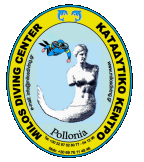|
Milos is the fifth largest island in the Cyclades with an area of 151sq. km,
positioned on the SW of the county. It is one of the lowest islands in the
Cyclades.
Its highest point is Prophet Elias with at 751m after
which follows Hondro Vouno. Milos island’s particular characteristic is its
natural harbour known as one of the largest and safest in the Mediterranean.
Milos is special because of its volcanic earth and for
its mineral rich subsoil. Its geological composition is primarily volcanic.
The volcanoes were active during the last 3,000,000 years and are now
dormant. As a result of past volcanic action, Milos is characterised by
numerous geological forms and golden-white beaches which captivateall
visitors.
Village of Milos
Milos has a population of 4500 inhabitants living in 8
villages on the NE part of the island. Plaka, the island’s capital, Plakes,
Tripiti, Triovasalos, Pera Triovasalos, Pollonia, Zephyria and Adamas, the
island’s port.
There are also smaller villages which are visited during
the summer. These are Paliohori, Provatas and Klima.
Adamas:
This village was built in 1835 by Cretans who fled to Milos after a failed
attack against the Turks. With its large natural harbour, Adamas is the
island’s tourist centre where a visitor will find restaurants, cafes, shops
and a news agency.
Pollonia:
Pollonia is a picturesque fishing village built around a natural gulf. It is
a popular tourist destination where the visitor will find restaurants and
small cafes. Boats depart daily from Pollonia to the neighbouring island of
Kimolos.
Plaka:
Plaka, the island’s capital is built at a height of 220m above sea level. It
has retained the traditional island architecture with its narrow streets and
a view of Milos’ harbour.
From here you can visit the
Archaeological Museum,
the
Folklore Museum
and the church of
Panagia Thalassitra.
Walk up to the remains of the Kastro built during the 13th
century by the Venetians.
Tripiti:
Leaving Plaka, vsitors come across the traditional village of Tripiti. It is
a beautiful village with a spectacular view of Milos’ harbour. This is where
the visitor will see the picturesque wind-mills, the church of
Agios Nikolaos, the
Catacombes and the Ancient Theatre.
Klima:
Klima is a small fishing village with few inhabitants. Here visitors will
see the ‘sirmata’ or boat-houses. The statues of the Venus de Milo and of
Praxiteli were found in farmland near this village.
Triovasalos – Pera
Triovasalos: These are the first
two villages that visitors come across after Adamas and are built
amphitheatrically on two facing hills. Restaurants and cafes can be found
here as well as many shops. It is worth visiting the churches of Agios
Spiridonas and Agios Georgios with its famous mosaic.
Zephyria:
Zephyria is a small village with 150 inhabitants. In the
past it was the island’s capital and is positioned 5.5 km SE of Adamas. It
is worth visiting the church of Panagia
Portiani built during the 17th
century. It is the oldest church in Zephyria and the old metropolis of Milos.
Beaches of Milos
on Milos you will
find about 70 beautiful beaches..
Lagada
and Papikinos:
Golden sand and
shallow blue water, near Adamas.
Paliohori:
Coastal village with a beautiful sand and pebble beach. Restaurants
and cafes can be found here. It is 8km from Adamas.
Provatas:
Coastal village with a beautiful beach and golden-red sand, rocks and
shallow water. Restaurants and cafes will be found here. It is 7km from
Adamas
Firiplaka & Tsigrado: Blue water,
grey sand and dreamlike scenery 8km from Adamas.
Agia Kyriaki:
Beautiful beach with thick sand and white pebbles. A restaurant and a beach
bar with water sports can be found here. It is 8km from Adamas.
Gerondas:
This is the most picturesque beach on the South side of the island with dark
sand, blue water and captivating scenery, you do have to walk however to get
to it.
Sarakiniko:
small and extra-ordinary beach named as the ‘Moon-scape’ by the Miloans.
Agios Constandinos,
Alogomandra, Papafraga:
Beaches
surrounded by capes, caves, natural bridges and small beaches.
|





